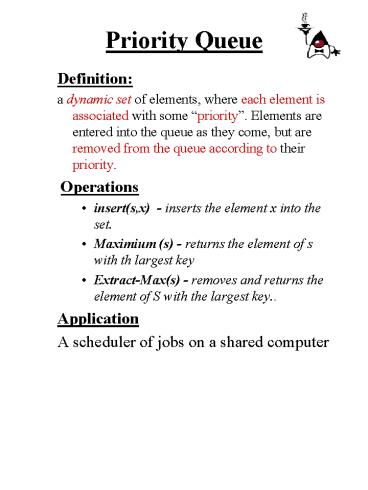Priority Queue - PowerPoint PPT Presentation
1 / 11
Title:
Priority Queue
Description:
Definition: a dynamic set of elements, where each element is associated with some 'priority' ... A sorting algorithm with a running time of O(n log n) ... – PowerPoint PPT presentation
Number of Views:223
Avg rating:3.0/5.0
Title: Priority Queue
1
Priority Queue
- Definition
- a dynamic set of elements, where each element is
associated with some priority. Elements are
entered into the queue as they come, but are
removed from the queue according to their
priority. - Operations
- insert(s,x) - inserts the element x into the
set. - Maximium (s) - returns the element of s with th
largest key - Extract-Max(s) - removes and returns the element
of S with the largest key.. - Application
- A scheduler of jobs on a shared computer
2
Heap Sort
- A sorting algorithm with a running time of O(n
log n) - The basic idea is to maintain a priority queue ,
and then each extracting each time the maximal
element at the head of the queue. - The goal
- To find the most efficinet implemntatoin ( data
structure ) for the priority queue and thus for
the heapsort.
3
Heap
- We could have used
- Linear list - insert O(1) , delete O(n)
- Ordered list - insert O(n) ,
delete O(1) - Binary Search Tree - insert and delete O(log n)
- the tree might get unbalanced and it suppotes
many unneeded operations. - The implementation used is called a binary heap,
which is the most commonly used.It is an array
implementing a partially ordered binary tree.
4
Partially Ordered Trees (POT)
- A data structure with efficient algorithm to
deal with priority queues. - Definition of POT
- A labeled, binary tree
- label contains a priority field (a field with
total order) - for every node n in POT
- n.priority gt n.left.priority of all nodes in
n.left-subtree (n.left) - n.priority gt n.right.priority of all nodes in
n.right-subtree (n.right) - The priority of the root is always the maximal
among all nodes in the tree, recursively. - What are the operation needed ?
5
Partially Ordered Trees (POT)
- The operations performed on the tree must not
effect its properties - Insert -
- Insert at the bottom of the tree, maintaining the
completeproperty. - Restore the POT property using bubble-up.
- Delete-Max -
- Delete the root (node with maximal priority)
- Replace (the root) with the last element in tree
(to maintain completeness) - Restore the POT property using bubble-down.
6
Partially Ordered Trees (POT)
void bubble-up (Node n) if n.parent
null or n.key lt n.parent.key return
else swap node n with n.parent bubble-up(n.p
arent)
void bubble-down (Node n) If (n.left
n.right null) return Node m
(n.left.key, n.right.key) if n.key gt
m.key return else swap nodes n,
m bubble-down (m)
T(n) O(h), h O(lg(n))
Why log(n)?
How to implement ?
7
Heap
- The binary heap data structure is an array object
that can be viewed as a complete partially
ordered binary tree . - For each node in position I in the array
left(i) return 2i right(i) return
2i1 parent(i) return i/2
8
Heap
- The heap is an efficient implementation of the
balanced partially ordered tree that represents
the priority queue. - It allows us to use the operations of the array (
retrieving elements according to their index ) ,
which are efficient and fast.
What are the operations needed ?
9
Heap OperationsHeapify - BubbleDown
heapify (A, i) l left (i) // indexes
of arrays used as pointers r right (i)
if l lt heap-sizeA and Al gt
Ai largest l else largest i
if r lt heap-size A and Ar gt Alargest
largest r if largest ! i exchange
Ai with Alargest heapify A, largest
// recursively correct subtree
T(n) O(h) O(lg n)
10
Heap OperationsBuildHeap
Given an unordered array A, transform A into a
Heap. (use heapify recursively, bottom up).
Build-heap (A) heap-sizeA lengthA
for j length A / 2 downto 1
heapify(A, j)
Why not the entire length?
11
Heap OperationsHeapSort
- Heapsort (A)
- build-heap(A)
- for k lengthA downto 2
- exchange A1 with Ak
- heapsizeA heapsizeA - 1
- heapify (A,1)
Delete-max
Why O (n log n)?





























